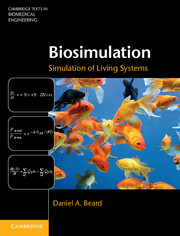Book contents
- Frontmatter
- Contents
- Preface
- Extracts
- 1 Introduction to simulation of biological systems
- 2 Transport and reaction of solutes in biological systems
- 3 Physiologically based pharmacokinetic modeling
- 4 Cardiovascular systems simulation
- 5 Chemical reaction systems: thermodynamics and chemical equilibrium
- 6 Chemical reaction systems: kinetics
- 7 Chemical reaction systems: large-scale systems simulation
- 8 Cellular electrophysiology
- 9 Appendices: mathematical and computational techniques
- References
- Index
5 - Chemical reaction systems: thermodynamics and chemical equilibrium
Published online by Cambridge University Press: 05 June 2012
- Frontmatter
- Contents
- Preface
- Extracts
- 1 Introduction to simulation of biological systems
- 2 Transport and reaction of solutes in biological systems
- 3 Physiologically based pharmacokinetic modeling
- 4 Cardiovascular systems simulation
- 5 Chemical reaction systems: thermodynamics and chemical equilibrium
- 6 Chemical reaction systems: kinetics
- 7 Chemical reaction systems: large-scale systems simulation
- 8 Cellular electrophysiology
- 9 Appendices: mathematical and computational techniques
- References
- Index
Summary
Overview
This and the following two chapters are focused on analyzing and simulating chemical systems. These chapters will introduce basic concepts of thermodynamics and kinetics for application to biochemical systems, such as biochemical synthesis, cellular metabolism and signaling processes, and gene regulatory networks. Although we have seen examples of chemical kinetics in previous chapters, notably in Sections 2.3 and 2.4, in those examples we developed the expressions governing the chemistry more from intuition than from a physical theory. One of the primary goals here will be to develop a formal physical/chemical foundation for analyzing and simulating complex biochemical systems.
As is our practice throughout this book, these concepts will be applied to analyze real data (and understand the behavior of real systems) later in this chapter and elsewhere. Yet, because the rules governing the behavior of biochemical systems are grounded in thermodynamics, we must begin our investigation into chemical systems by establishing some fundamental concepts in chemical thermodynamics. The concept of free energy is particularly crucial to understanding thermodynamic driving forces in chemistry. We will see that both a physical definition and an intuitive understanding of free energy require physical definitions and intuitive understandings of temperature and entropy. All of this means that this chapter will begin with some abstract thought experiments and derivations of physical concepts.
Temperature, pressure, and entropy
Microstates and macrostates
All thermodynamic theory arises from the fact that physical systems composed of many atoms and/or molecules attain a large number (often a practically infinite number) of microstates under defined macroscopic conditions, such as temperature, pressure, and volume.
- Type
- Chapter
- Information
- BiosimulationSimulation of Living Systems, pp. 145 - 177Publisher: Cambridge University PressPrint publication year: 2012

